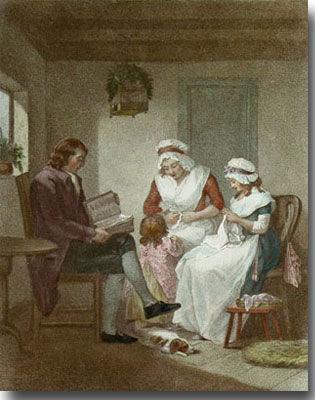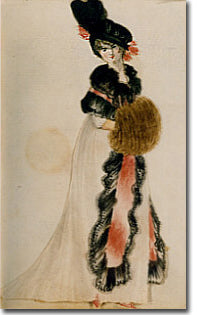The Masked Ball
On Twelfth Night we had a delightful evening...about our dress King and Queen, W Morris was King, I was Queen, Papa-- Prince Busty Trusty, Mama-- Red Riding Hood, Edward-- Paddy O'Flaherty, G.-- Johnny Bo-peep, H.-- Timothy Trip, W.-- Moses Abrahams, Eliz.-- Mrs O'Flaherty, Ma.-- Granny Grump, C-- Cupid (by his own desire), Louisa-- Princess Busty Trusty, Uncle H.B.-- Punch, Aunt H.B.-- Poll Mendicant, Jane-- Punch's Wife, Mary-- Columbine, Uncle John-- Jerry the Milkman, Mrs Morris-- Sukey Sweetlips, Sophia-- Margery Muttonpie. Soon After, according to a preconstructed plan, some of us retired upstairs to dress Jane as Punch's wife, in a witches hat, a green petticoat and a scarlet shawl (the remains of our last year's masquerade) Mrs M.J. and I in beggars clothes to sing carols at the parlour door, and myself in a long scarlet cloak for a royal robe and a wreath of natural primroses (which we had gathered and made up in the morning for whoever would be queen) around my head. Fanny Austen to Miss Dorothy Clapman February, 1812
 A masquerade ball (or bal masqué) is an event which the participants attend in costume wearing a mask. Such gatherings, festivities of Carnival, were paralleled from the 15th century by increasingly elaborate allegorical Entries, pageants and triumphal processions celebrating marriages and other dynastic events of late medieval court life. Masquerade balls were extended into costumed public festivities in Italy during the 16th century Renaissance. They were generally elaborate dances held for members of the upper classes, and were particularly popular in Venice. They have been associated with the tradition of the Venetian Carnival. With the fall of the Venetian Republic at the end of the 18th century, the use and tradition of masks gradually began to decline, until they disappeared altogether.
They became popular throughout mainland Europe in the 17th and 18th centuries, sometimes with fatal results. Gustav III of Sweden was assassinated at a masquerade ball by disgruntled nobleman Jacob Johan Anckarström, an event which Eugène Scribe and Daniel Auber turned into the opera Gustave III. John James Heidegger, a Swiss count, is credited with having introduced the Venetian fashion of a semi-public masquerade ball, to which one might subscribe, to London in the early eighteenth century, with the first being held at Haymarket Opera House. Throughout the century the dances became popular, both in England and Colonial America. Its prominence did not go unchallenged; a significant anti-masquerade movement grew alongside the balls themselves. The anti-masquerade writers (among them such notables as Samuel Richardson) held that the events encouraged immorality and "foreign influence". While they were sometimes able to persuade authorities to their views, enforcement of measures designed to end masquerades was at best desultory.
Masquerade balls were sometimes set as a game among the guests. The masked guests were supposedly dressed so as to be unidentifiable. This would create a type of game to see if a guest could determine each other's identities. This added a humorous effect to many masques and enabled a more enjoyable version of typical balls. The idea of masks and costumes was particularly popular during Twelfth Night revels.
The picturesque quality of the masquerade ball has made it a favorite topic or setting in literature. Edgar Allan Poe's short story "The Masque of the Red Death" is based at a masquerade ball in which a central figure turns out to be exactly what he is costumed as. Another ball in Zürich is featured in the novel Steppenwolf by Hermann Hesse. "Regency" romance novels, which are typically about Britain's upper class "ton" during the 1800s, often make use of masquerade balls as settings, due both to their popularity at the time and to their endless supply of plot devices.
The following fashion plates show suggested costumes for various masked events.
A masquerade ball (or bal masqué) is an event which the participants attend in costume wearing a mask. Such gatherings, festivities of Carnival, were paralleled from the 15th century by increasingly elaborate allegorical Entries, pageants and triumphal processions celebrating marriages and other dynastic events of late medieval court life. Masquerade balls were extended into costumed public festivities in Italy during the 16th century Renaissance. They were generally elaborate dances held for members of the upper classes, and were particularly popular in Venice. They have been associated with the tradition of the Venetian Carnival. With the fall of the Venetian Republic at the end of the 18th century, the use and tradition of masks gradually began to decline, until they disappeared altogether.
They became popular throughout mainland Europe in the 17th and 18th centuries, sometimes with fatal results. Gustav III of Sweden was assassinated at a masquerade ball by disgruntled nobleman Jacob Johan Anckarström, an event which Eugène Scribe and Daniel Auber turned into the opera Gustave III. John James Heidegger, a Swiss count, is credited with having introduced the Venetian fashion of a semi-public masquerade ball, to which one might subscribe, to London in the early eighteenth century, with the first being held at Haymarket Opera House. Throughout the century the dances became popular, both in England and Colonial America. Its prominence did not go unchallenged; a significant anti-masquerade movement grew alongside the balls themselves. The anti-masquerade writers (among them such notables as Samuel Richardson) held that the events encouraged immorality and "foreign influence". While they were sometimes able to persuade authorities to their views, enforcement of measures designed to end masquerades was at best desultory.
Masquerade balls were sometimes set as a game among the guests. The masked guests were supposedly dressed so as to be unidentifiable. This would create a type of game to see if a guest could determine each other's identities. This added a humorous effect to many masques and enabled a more enjoyable version of typical balls. The idea of masks and costumes was particularly popular during Twelfth Night revels.
The picturesque quality of the masquerade ball has made it a favorite topic or setting in literature. Edgar Allan Poe's short story "The Masque of the Red Death" is based at a masquerade ball in which a central figure turns out to be exactly what he is costumed as. Another ball in Zürich is featured in the novel Steppenwolf by Hermann Hesse. "Regency" romance novels, which are typically about Britain's upper class "ton" during the 1800s, often make use of masquerade balls as settings, due both to their popularity at the time and to their endless supply of plot devices.
The following fashion plates show suggested costumes for various masked events.

Masquerade Dress Galerie des Modes
This image is from a French fashion journal c. 1778-1787. Note the feathered evening hat. In Isabelle de Charriere's 1782 Letters from Mistress Henley, Mistress Henley and her husband argue over her wearing such a hat to a ball. Such a hat is also seen in the famous Gainsborough, Hon. Frances Duncombe c. 1777, now used as the cover picture of the Oxford University Press edition of Frances Burney's Cecilia (1782).
 An Egyptian Costume, July 1807
Le Beau Monde
An Egyptian Costume, July 1807
Le Beau Monde
The head-dress is composed of a rich handkerchief of white lace, which crosses the back part of the head; each corner of the handkerchief, a small distance from the shoulder, falls on the front of the neck; the handkerchief is trimmed round with a magnificent border of peals, and each corner is finished with a bunch of the same; the hair is curled on the top of the forehead with small thick curls, separated with a band of diamonds, which crosses the forehead, and continues round the head; two small curls down the side of the face. A rich white figured sarsnet dress made with a short train, and scolloped back; sleeves very short and covered with a broad flap of white lace; the undersleeve is trimmed round with small French pearls; also the lace, which is fastened to the back part of the sarsnet sleeve with a star of pearls; the front is made full each way, and covered with rich lace fastened in the centre with a star to correspond with the sleeves. An Egyptian train of lilac spider net, showered with pearls, and worked in the centre with a large star of the same, cut in the form of a half handkerchief, wider a one end than at the other; one end is cut square, and gathered up full on the left shoulder with a pearl star; a piece of sarsnet, from under the left arm, richly ornamented, crosses the front, and is fastened with the middle corner of the train to the right knee with a bunch of pearls; the other corner, which reaches to the bottom of the dress, is finished with a large pearl tassel; the dress and train are trimmed round with pearls to correspond. White kid gloves and shoes.
 Masquerade Dress, 1826
Wiener Modenzeitung
Masquerade Dress, 1826
Wiener Modenzeitung
After the biweekly Wiener Modenzeitung began publication in 1816, it became the voice of the Viennese couturiers. Artists like the painter Johann Ender (1793-1854) and Philipp von Stubenrauch (1784-1848), director of the costume workshops of the imperial theaters, illustrated the original designs of the Viennese designers, which were often produced as hand-colored fashion plates. The magazine was renamed the Wiener Zeitschrift fur Kunst, Literartur und Mode when it changed its editorial scope and became a general-interest publication.
Historical information from Wikipedia.com. Fashion plates and descriptions from Cathy Decker's Regency Fashion Page. Find your own Masks online at Dressing Up Online.co.uk. Enjoyed this article? Visit our giftshop and escape to the world of Jane Austen for costume, patterns and more.



Leave a comment
This site is protected by hCaptcha and the hCaptcha Privacy Policy and Terms of Service apply.